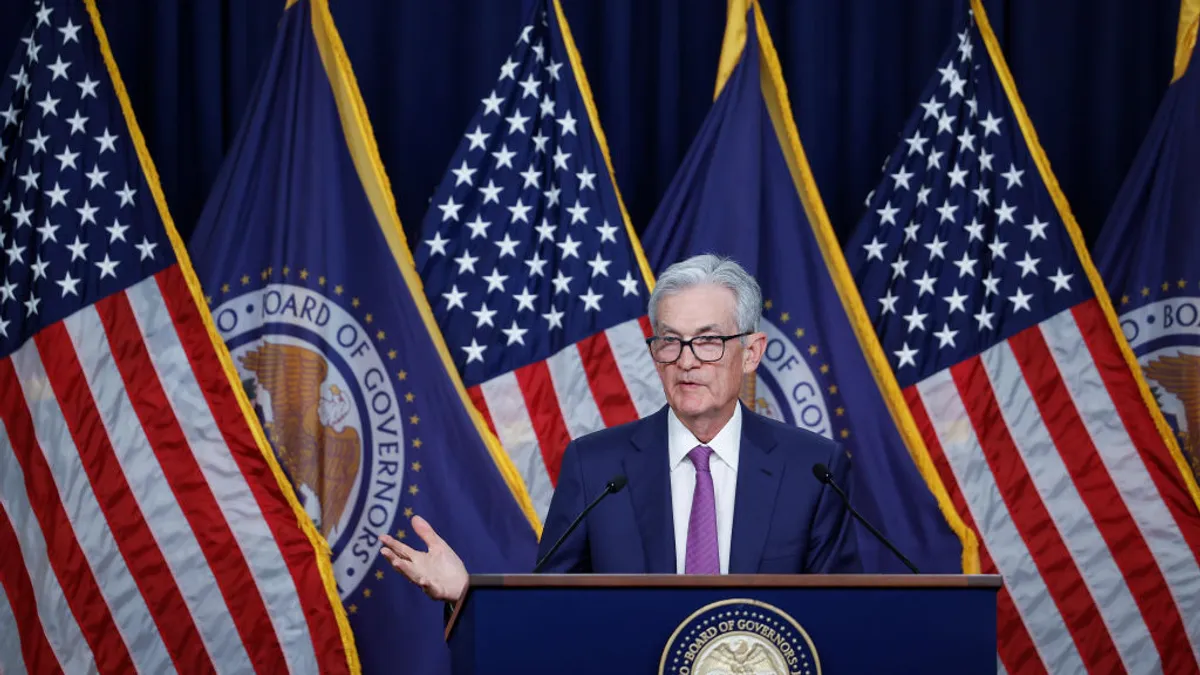Dive Brief:
-
The Federal Reserve on Wednesday cut the main interest rate by a half percentage point to a range between 4.75% and 5%, citing progress in slowing inflation toward the central bank’s 2% goal from more than 9% two years ago.
-
“This decision reflects our growing confidence that with an appropriate recalibration of our policy stance, strength in the labor market can be maintained in a context of moderate growth and inflation moving sustainably down to 2%,” Fed Chair Jerome Powell said at a press conference. Central bank officials expect to trim the federal funds rate to 4.4% by December and to 3.4% by the end of next year, according to the median of their projections released Wednesday.
-
Fed officials forecast that inflation as measured by the core personal consumption expenditures price index, excluding food and energy, will end 2024 at 2.6%, the same level as July, and at 2.2% by the end of next year, according to their median projections. They see unemployment rising from 4.2% in August to 4.4% in December 2024.
Dive Insight
Eleven of the central bank’s 12 policymakers supported the half-point reduction, with Governor Michelle Bowman dissenting in favor of a quarter-point trim.
Yet Bowman and the remaining 18 Fed officials who participated in the two-day policy meeting favored multiple cuts to the federal funds rate this year, Powell said, citing the projections released Wednesday.
“Seventeen of the 19 wrote down three or more cuts, and 10 of the 19 wrote down four or more cuts,” he said. “There is a dissent and there is a range of views, but there’s actually a lot of common ground as well.”
Fed policymakers weeks ago signaled the cut to borrowing costs by noting that, after focusing for more than two years on their mandate to ensure stable prices, the cooling job market had prompted them to turn more to their other congressional directive of promoting maximum employment.
“The upside risks to inflation have diminished and the downside risks to employment have increased,” Powell said. “We now see the risks to achieving our employment and inflation goals as roughly in balance.”
Payroll growth has slowed this year, while unemployment rose to 4.2% last month from 3.7% in December as more workers entered the labor force and companies trimmed hiring plans.
At the same time, declining manufacturing demand and slowing production levels have crimped the supply chain. Manufacturing production levels hit a four-year low in August, according to the Institute for Supply Management’s August PMI, pushing inventories to rise.
Before the Fed’s policy easing, economists and Wall Street analysts were split over whether policymakers would cut by a half point, to forestall a downturn and widespread unemployment, or by a quarter point, to minimize the odds of a resurgence in price pressures.
“We know that reducing policy restraint too quickly could hinder progress on inflation,” Powell said Wednesday. “At the same time, reducing restraint too slowly could unduly weaken economic activity and employment.”
Before shifting away from their most aggressive tightening in four decades, Fed policymakers needed to interpret mixed signals from the economy.
Even as the job market cooled, retail sales unexpectedly rose 0.1% last month, a Commerce Department data report showed Tuesday.
Most of the report’s 13 categories fell, including sales of clothing, gasoline, furniture and electronics, the Commerce Department said. Yet e-commerce sales gained 1.4% while personal care and building materials and garden suppliers also increased.
More broadly, economic growth this year has exceeded the expectations of Fed officials and many private sector economists.
Gross domestic product will probably expand at a 2.9% annual rate during the third quarter, the Atlanta Fed said Wednesday. The economy grew at annual rates of 1.4% in the first quarter and 3% in the second quarter, according to the Bureau Economic Analysis.
Fed officials, in their median projection, see GDP growing 2% this year, a downgrade from their 2.1% forecast in June. They expect the economy to expand 2% both next year and in 2026, unchanged from their June projections.
“The U.S. economy is in a good place and our decision today is designed to keep it there,” Powell said, adding that “the labor market is still in solid shape.”
“I don’t see anything in the economy right now that suggests that the likelihood of a recession — sorry, of a downturn — is elevated,” he said. “You see growth at a solid rate, you see inflation coming down and you see a labor market that’s still at solid levels.”
Central bank officials expect that the federal funds rate will end this year at 4.4%, based on their median projections, and at 3.4% in 2025, 2.9% in 2026 and, over the longer run, at 2.9%.
The U.S. will probably not return to a period of near-zero interest rates similar to that preceding the pandemic, Powell said. “My sense is that we’re not going back to that, but you know, honestly, we’re going to find out.”
Fed officials expect continued progress in their fight against inflation, estimating that core PCE will fall to 2.6% this year, 2.2% next year and to their 2% goal in 2026, according to their median projections.
Commenting on the Fed’s fight against inflation, Powell said, “we’re not saying mission accomplished or anything like that, but I have to say we’re encouraged by the progress that we have made.”















